 French bodybuilder Valerie Creux.
French bodybuilder Valerie Creux.
Results matching “Bird”
 French bodybuilder Valerie Creux.
French bodybuilder Valerie Creux.
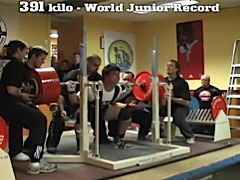 Via Rif's Blog : Here's a name to remember - Magnus Önerud (Swedish site). Incredible.
Via Rif's Blog : Here's a name to remember - Magnus Önerud (Swedish site). Incredible.
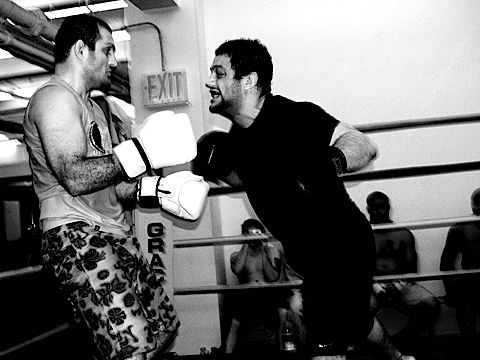
Ralph Gracie training with Ryan Gracie (1974 - 2007), sometime in 2005. Photo via Whoa.
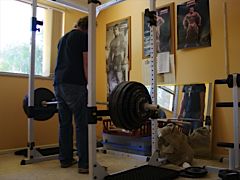
Of all the places I work out, the Home Gym is by far my favourite. Always there, ready for action whenever I get the chance. Today I'll take a brief look at the contents of my own home gym, a few things I'd like to add and the many reasons this is such a great location for training.
My own home gym - what's in it?
The home gym setup I've been using for several years now hasn't changed all that much (despite having moved house quite a few times), and includes :
- A power rack (buyers' guide)
- Olympic and standard bars (various kinds)
- Flat bench
- A good assortment of plates
- Dumbbells and Kettlebells (buyers' guide)
- Bands
- Various grip tools
- A range of odd objects and outdoor equipment (anvil, sledgehammer, rope etc)
- Sandbag
- Exercise bike
A few things I'd like to add
Naturally, there are quite a few things I'd love to add to the above list (if space and money were unlimited, of course) :
- Back Attack
- Revolving climbing wall
- Pegboard
- Leg press machine
- Outdoor equipment (this sort of thing)
- Reverse Hyper
- Rowing machine (probably one of these)
- Underwater treadmill
- Power Squat
 In this series Blaine and I will be looking at just some of the ways to take advantage of your location when it comes to working out. No matter what your idea of ‘working out’ is, there are several things you can do right where you are.
In this series Blaine and I will be looking at just some of the ways to take advantage of your location when it comes to working out. No matter what your idea of ‘working out’ is, there are several things you can do right where you are.
Of all the places I work out, the Home Gym is by far my favourite. Always there, ready for action whenever I get the chance. Today I'll take a brief look at the contents of my own home gym, a few things I'd like to add and the many reasons this is such a great location for training.
My own home gym - what's in it?
The home gym setup I've been using for several years now hasn't changed all that much (despite having moved house quite a few times), and includes :
- A power rack (buyers' guide)
- Olympic and standard bars (various kinds)
- Flat bench
- A good assortment of plates
- Dumbbells and Kettlebells (buyers' guide)
- Bands
- Various grip tools
- A range of odd objects and outdoor equipment (anvil, sledgehammer, rope etc)
- Sandbag
- Exercise bike
A few things I'd like to add
Naturally, there are quite a few things I'd love to add to the above list (if space and money were unlimited, of course) :
- Back Attack
- Revolving climbing wall
- Pegboard
- Leg press machine
- Outdoor equipment (this sort of thing)
- Reverse Hyper
- Rowing machine (probably one of these)
- Underwater treadmill
- Power Squat
The benefits of a home gym
There are several positive aspects to any home gym, regardless of its size or location around the house. These include :
- Chalk is allowed : although I can understand the reasons this powdery substance is often denied entry to the weight-room, it's great to be able to use it. My own weapon of choice - the chalk ball
.
- You choose the music : the music playing during a workout is there largely to motivate you. Although it seems like a minor thing compared to the lift itself, it's much easier to produce a PR or two when you like the stuff coming out of the speakers.
- Free from distractions : my own home gym isn't exactly a peaceful place, but it's great to know that I'm the one clanking the plates and turning up the music.
- Always available : whenever I'm in the mood to throw the iron around - even it it's 3am - I can simply wander into the home gym and get to work. Superb.
- Set up just the way you like it : for me, this is a big one. I'll stop short of saying I'm a control freak, but I do like to have a pretty good idea of the outcome before I start something.
- Unusual exercises are allowed : experimentation is always good (well, most of the time). I like the freedom to test variations on the common moves, practice some of the older exercises and generally just try things out.
Inspiration rather than rules : The home gym is not the place for external limitations. Commercial gyms seem to focus on the things you can't do, rather than the things you've already achieved.
In the home gym you can replace the rules list with a much more inspirational board. Jot down the things you've already done - that squat PR you set last week, your CoC #3 close and so on.
- Toffe's Gym : This is the ultimate outdoor gym. Superb.
- Ice Chamber : When it comes to mixing things up, this is definitely at the top of the list.
Sources of inspiration : Other home gyms I love the look of
It's always great to see how other people set things up. A couple of personal favourites :
Final thoughts on training in a home gym
Overall, I love it. No matter how much room or money you have available, a home gym can be a magical place.
Also in this series :
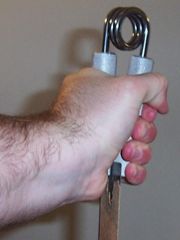 Jedd just pointed me to next year's Victorian Grip Challenge. Looks like a good one.
Jedd just pointed me to next year's Victorian Grip Challenge. Looks like a good one.
 Via Mark Webber Challenge : Teaming up with Aaron Prince and Gordon Walker, adventure racers Richard & Elina Ussher took line honours at this year's Abu Dhabi Adventure Challenge. More results here.
Via Mark Webber Challenge : Teaming up with Aaron Prince and Gordon Walker, adventure racers Richard & Elina Ussher took line honours at this year's Abu Dhabi Adventure Challenge. More results here.
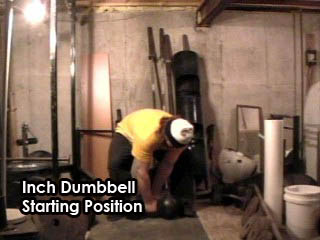
In the last article on Lifting the Inch Dumbbell, I looked at varying the percentage of 1-rep maximum, and the speed of the repetitions we executed. This variety will keep your grip workouts interesting, and keep the increases in strength coming.
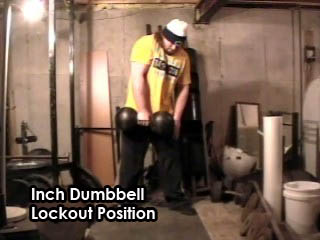
This time, I’d like to discuss varying the distance we pull the implements. There is a correlation between how long (time) the effort will last and how far (distance) you will have to pull the implement in order to deadlift it from the floor to the fully locked out position. For me, this distance is about 2.5 feet. The time will vary depending on how I am feeling on the given day, but for me, it takes bout 1 full second to pull the inch to lockout.
In order to effectively train to lift the inch from the floor to lockout, your training should reflect that distance.
Loadable Dumbbells and Shot Loadable Trainers
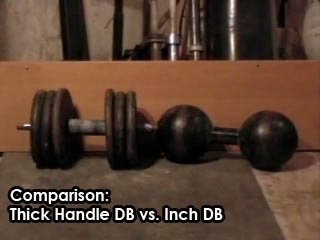
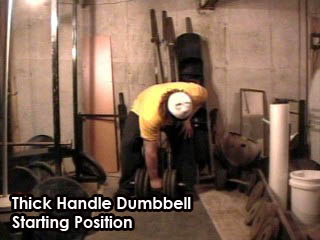
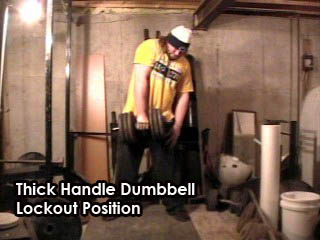
A loadable dumbbell is excellent for replicating the distance you have to pull the Inch. Load the dumbbell with 25-pound plates in order to most accurately replicate the height of the dumbbell at the starting point on the floor. As you can see, the handle sits at nearly the same height when the dumbbell is loaded with 25’s. If you load it with 35’s or 45’s the handle will sit higher, and the length of your pull will be shorter.
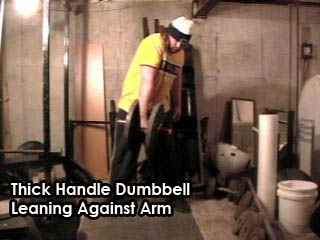
Loading 25’s instead of the larger plates also ensures that the edges of the plates will not brush against your forearm as the implement tilts when you lift. Called bracing, this leaning of the weight will make the lift easier and make the effectiveness of the lift reduced.
Shot-loadable Inch Trainers
Shot-loadable Inch Trainers will also accurately imitate the pull length of the Inch Dumbbell, because their size and shape is patterned very closely after the design of the original Inch Dumbbell. They do fall somewhat short on the complete simulation of the lift however, because the shot tends to settle and not move when you lift the implement. Because the implement does not try to spin out of your hand, you do not get an accurate display of the grip-ripping action that the Inch Dumbbell creates.
Rolling Thunder
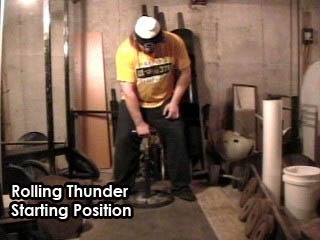
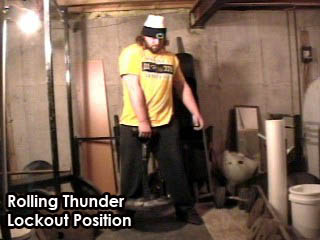
The pull distance is one way the Rolling Thunder falls short for training to lift the Inch Dumbbell. The path over which one pulls the Rolling Thunder is abbreviated in comparison to a lift on the Inch Dumbbell, a loadable dumbbell or a shot loadable replica. When lifting the Rolling Thunder, you start in a nearly locked out position. In contrast, the starting position for lifting the Inch Dumbbell is bent over. While the stimulus you get from the handle is fairly accurate due to its large size and its rotating nature, the duration of effort over the distance is just not there.
This is not to say that the Rolling Thunder should not be used as a method for training to lift the Inch Dumbbell. You can easily modify the kinetics of the Rolling Thunder lift so that it more closely resembles the pulling path of the Inch Dumbbell.
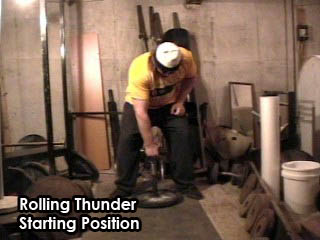
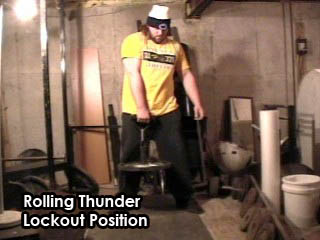
One thing you can do to change the Rolling Thunder lift is to reduce the length of the loading pin you use, or completely eliminate it altogether. Now, your starting position will be much lower and the path you pull to lockout will be much longer.
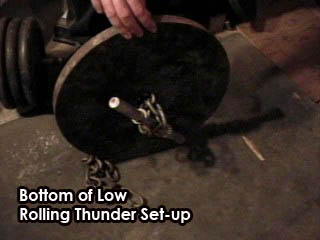
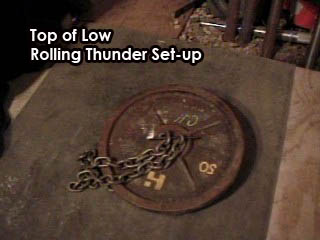
You can make the starting position in the Rolling Thunder lift very low by stringing a chain through the center hole of the plates and locking it in place with an empty dumbbell handle on the bottom and a spare nail through the top. The v-shaped bottom of the Rolling Thunder will go between the two lengths of chain and beneath the nail.
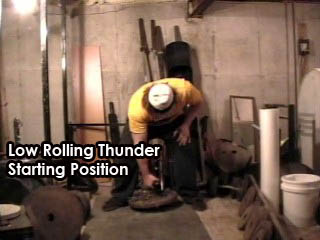
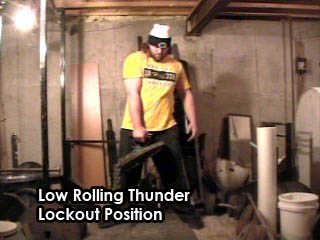
Using a non-rigid loading device like the chain will bring about more movement and sway in the lift, which can also help you get used to the Inch Dumbbell trying to rip out of your grasp. The Rolling Thunder alone does this somewhat, but the action is more controlled than the Inch Dumbbell itself.
Extension of the Movement – Increased Pull Path
One technique we use at Diesel Crew to make or lifts more demanding is what we call Extension of the Movement. Making your training lifts more demanding will make your basic lift easier to complete when you go back to it.
There are many ways to make a lift more difficult. One way is by increasing the distance you have to pull an implement.
Let’s take the loadable dumbbell as an example. We have already established that if we do not have an Inch Replica, we should use something that is very close to it to train as effectively as we can for the real thing. The Loadable Dumbbell has the thick handle we need in order to simulate the handle of the Inch. We load it with 25’s so that we can avoid bracing. We should check to be sure that the weights are loaded as tightly as possible. If the weights are loaded loosely, they will rotate freely and you will lose the grip-ripping effect that the Inch Dumbbell throws at you. We have now created an implement that simulates the Inch Replica Dumbbell very well, but of course it is not perfect.
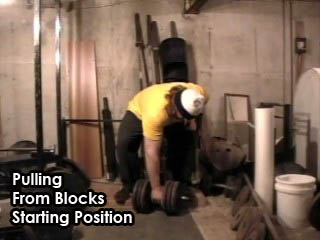
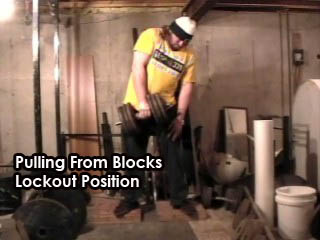
We can introduce another layer of difficulty by pulling off blocks. The increased range of motion combined with making the implement as accurate as we can will increase our effort levels and help us become better prepared for attempting to lift the real thing.
Pulling from boxes can also be used to make the Rolling Thunder more closely resemble the pull path of the Inch Dumbbell, if you do not want to mess with the chain set-up that we saw above.
Extension of the Movement – Increased Pull Path
Another way I like to incorporate Extension of the Movement is by using giant rubber bands. Two great sources for rubber bands of this sort are EliteFTS.com and IronWoody.com.
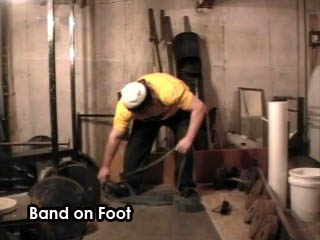
I start out by wrapping the band around one foot.
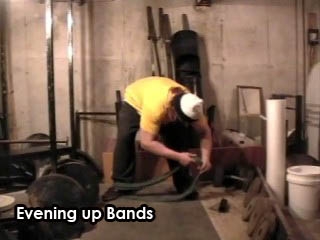
Next, I even out the bands so they are flat.
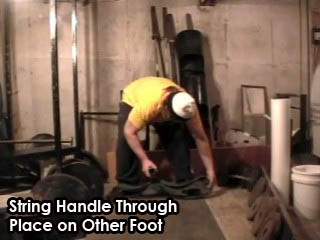
I string the Rolling Thunder over the bands and stick my other foot inside both bands.
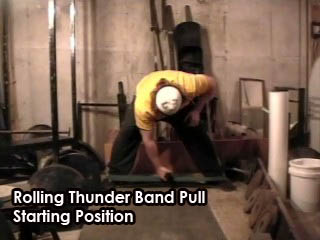
Once the Rolling Thunder is in the center of the bands, you are ready to pull.
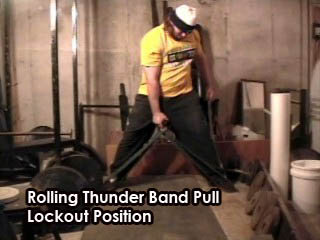
Bands are great for what is called Accommodating Resistance. Simply put, the further you pull, the harder the lift gets. Believe me, at lockout it feels like you’re pulling almost 200 pounds.
At the beginning of this series, we started out learning about the implements we could use to simulate the Inch Dumbbell. Now we know several methods for varying the load and speed we move these implements, and we know how we can kinetically alter the pull path of these implements. Our training arsenal is growing.
It will grow more next time when we see what other ways we can use these implements to prepare us for battle with the inch.
NAPALM
DieselCrew.com
Napalm's Corner
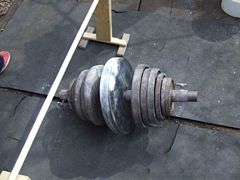 Jedd points to the results of this year's Gripmas Carol. Nice one.
Jedd points to the results of this year's Gripmas Carol. Nice one.
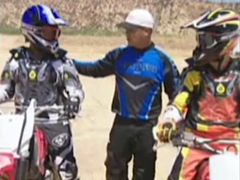 Ready to do a little riding off-road? Swing by DirtBike School.
Ready to do a little riding off-road? Swing by DirtBike School.
